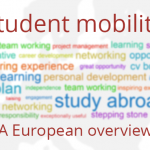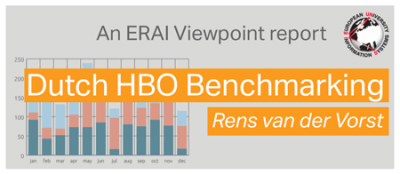IT BENCHMARK 2014 Dutch Higher ED
Rens van der Vorst @Rensvandervorst
“A benchmark is not about numbers. It is about a story that needs to be told”
A few years ago I was blindsided by an IT benchmark that was presented by some high profile consultancy company to our board. The benchmark was sloppy, full of mistakes but nevertheless: I found myself defending the IT-department. The only thing I could think about after the meeting was: never again!
So, together with 4 other universities we started our own IT benchmark. At the start of the project we defined our goals. And they were ambitious.
- Design a framework which allows the universities to compare real costs. Compare apples to apples;
- Design a framework that is at the same time high level and detailed enough to learn from each other;
- Design a framework that is detailed enough to compare prices that are being paid for licenses and maintenance. If irregularities exists the companies have to explain;
- Make sure major developments in IT and higher education like BYOD or Cloud are immediately visible in the framework;
- Present all costs in an attractive way. Per example costs per user, per student or as a percentage of the total costs. Make sure the presented data is lively and has context;
- Make sure size and usage are part of the framework. This makes it possible to see costs in relation to usage and present trends about usage.
Four years later, in 2014, nine Dutch universities participated. Together they represent 200.000 students, 20.000 employees and a revenue of 1.6 billion euros.
Universities were able to save 250.000 euros per year by discussing the data in the benchmark with IT – companies and by learning from each other.
The most interesting part of the benchmark however where the stories the data told us. Benchmarks are not boring, not made for number crunchers or accountants. No! Benchmarks tell stories that raise questions, excite and challenge universities to improve!
These are some of those stories!
IT? Why do we do IT?
Our benchmark started with a simple question. How much does it cost to provide education for one student per year? That was easy to calculate and we immediately saw interesting results. The cost vary immensely even between universities that do the same type of education. How can that be? And how is it possible that some of the best universities in the Netherlands provide education for lower costs than other universities? The employee – student ratio also differs. This becomes especially interesting if placed in time. There are universities that have had the same ratio for 15 years. This raises an interesting question. If you do basically the same work with the same number of people and we provided you with all those beautiful IT – solutions, than employees must have all the time of the world. Or haven’t they? No, they are busier than ever. How can that be? Are we using IT for our benefit? Or not?
Never. Never! Save money on the WIFI!
The Dutch Benchmark shows that it costs 8.157 euros a year to provide a student with education. From that 8.157 euro, 6,50 euro is spend on the wireless network. That is 0,08%. And this is the most important service we provide for our student! If it doesn’t work, the impact is very high.
BYOD is for REAL!
The Dutch benchmark shows the explosive growth of the number of devices on the network. It also shows the WIFI is pushing the (more expensive) wired network to the background. But who cares, the total costs of the network infrastructure (LAN, WAN + Management) is only 0,5% of the total budget of the university. If you decide to cut costs on the network, remember, there is not a lot of money to be found but a lot of damage to be done!
Never. Never! Trust an IT – company
With the Dutch benchmark it is pretty easy to compare maintenance and license costs. We saw that some universities were paying way more per network connection than other universities. And they had contracts with the same IT – company. The result? A discussion which proved the IT- company made a ‘mistake’. Some universities saved a lot of money because of these mistakes.
Weather report: Clear skys in the Netherlands!
We hear a lot about the cloud but do we see it in our benchmark? Do we see a lot of IAAS, PAAS or SAAS? The answer is no! And this is understandable. The total costs of the datacenter (including management) is on an average 0,40% of the budget of the university. So, again, cloud sounds great but it is not the holy grail to save costs. And if you choose poorly, the impact can be devastating.
Consumerization of IT is a Fact
The benchmark clearly shows the consumerization of IT. Our employees want more devices, the want nice devices and the want to change them more often. There is a rise of smartphones and tablets and every year a larger part of the budget is going to the personal devices. The import question is of course the relevance for the quality of education. If you know the answer, please send me an e-mail.
Smart boards stupid teachers!
There is a lot of screens, weblecture systems and smart boards in our buildings and every year it becomes more. Most universities spend more money on audiovisuals than on personal devices. A large chunck also goes to the management because users often do not know how to operate the audiovisuals. Hence, smart boards, stupid teachers!
I have an iPad, an Iphone and an iPrinter!
Employees are having all these devices but does it mean that they print less? No. An employee prints 8500 pieces of paper a year. Fontys university invested in 3000 tablet and it resulted in 4% less prints. From a benchmark perspective paperless is more.
Love me Tender!
If we buy something new often we do this via an European Tender. The benchmark has proven very valuable. It provides answer to questions like: who is using what? What are they paying? And it really helps to make strategic choices. And it saves on expensive consultancy companies.
Do we really need those applications?
In the Dutch benchmark you can see who is using what applications. The results are stunning. Some universities spend millions on a CRM – application other universities don’t even have one. How can that be? What is the story behind it? That are important questions.
One IT department? Hundreds!
In the personnel section of the benchmark there is a lot of valuable information. You can see what you are paying them vs the other universities. You can see what part is spend on outsourcing, on management, on innovation, on support and so on.
The most interesting part however is that less and less IT – personnel is employed by the IT – department. Every department is becoming an IT – department. And who is controlling it?
You can talk hours about the stories above and they are only a small part of the stories that can be told. That is the essence of benchmarking. It makes you think about what you are doing and it makes you understand what other people are doing. And if you think and understand it will help you make the right decisions.
On the next page you see the rubrics that are filled out in the Dutch Benchmark. These are only the main rubrics, there is a lot more (detailed) information per rubric.
If you have any questions do not hesitate to contact me on: r.vandervorst@fontys.nl or @rensvandervorst.











